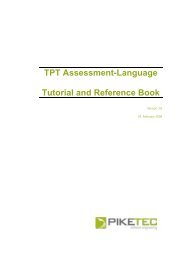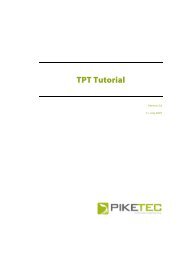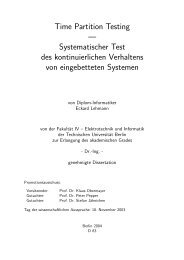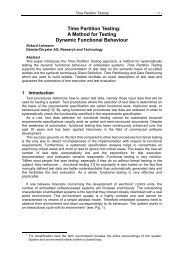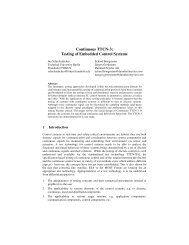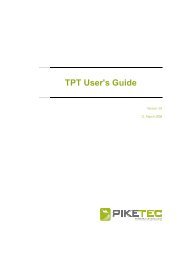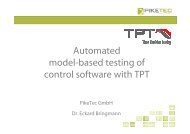TPT User's Guide - PikeTec
TPT User's Guide - PikeTec
TPT User's Guide - PikeTec
Create successful ePaper yourself
Turn your PDF publications into a flip-book with our unique Google optimized e-Paper software.
<strong>TPT</strong> <strong>User's</strong> <strong>Guide</strong> Page 11<br />
2.3 Creating a declaration<br />
Figure 2: The declaration editor<br />
In order to create a new table entry one has to empty the editor’s input fields located right<br />
below the table by clicking the button labelled “Clear” and then fill these fields with the values,<br />
that describe the new entry:<br />
Type<br />
This drop-down list allows a user to choose which type of declaration is to be created.<br />
Name<br />
This text input field expects a unique string for the new declaration which must follow the<br />
restrictions imposed by <strong>TPT</strong>.<br />
Location<br />
This text field takes an optional URI that may contain additional information about a<br />
declaration’s external location (if it has one). The exact semantics of an “external location” are<br />
specific to different test execution environments.<br />
Group<br />
This text field takes an optional arbitrary group name, which may be used to easily categorize<br />
declarations according to the user’s requirements.<br />
Data Type<br />
This drop-down list requires a data type to be chosen for the new declaration.<br />
Value<br />
This text field expects a default value to be entered for the declaration. Naturally this value has<br />
to be compatible with the selected data type.<br />
Volatile<br />
This check box is only available for channels. When selected, the channel to be created will be<br />
“volatile”, which refers to the behaviour of the values of the channel over time. While a value<br />
that has been written to a non-volatile channel at a certain point in time persists to later times,<br />
a volatile channel discards its current value when time increments to the next ‘instant’.




